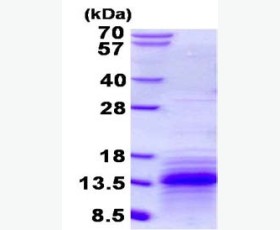Recombinant Human Hepatocyte Cell Adhesion Molecule/HepaCAM
| Product name: | Recombinant Human Hepatocyte Cell Adhesion Molecule/HepaCAM |
| Source: | Human Cells |
| Purity: | Greater than 95% as determined by reducing SDS-PAGE. |
| Buffer Formulation: | Lyophilized from a 0.2 μm filtered solution of 20mM PB, 150mM NaCl, pH 7.2. |
| Applications: | Applications:SDS-PAGE; WB; ELISA; IP. |
| Storage: | Avoid repeated freeze/thaw cycles. Store at 2-8 oC for one month. Aliquot and store at -80 oC for 12 months. |
| UOM: | 100ug/50ug/200ug/1mg/1g |
| Source | Human Cells |
| Description | Recombinant Human HepaCAM is produced by our Mammalian expression system and the target gene encoding Val34-Ser240 is expressed with a 6His tag at the C-terminus. |
| Names | Hepatocyte Cell Adhesion Molecule, Protein HepaCAM, HEPACAM |
| Accession # | Q14CZ8 |
| Formulation | Lyophilized from a 0.2 μm filtered solution of 20mM PB, 150mM NaCl, pH 7.2. |
| Shipping |
The product is shipped at ambient temperature. |
| Reconstitution |
Always centrifuge tubes before opening. Do not mix by vortex or pipetting. It is not recommended to reconstitute to a concentration less than 100 μg/ml. Dissolve the lyophilized protein in ddH2O. Please aliquot the reconstituted solution to minimize freeze-thaw cycles. |
| Storage |
Lyophilized protein should be stored at < -20°C, though stable at room temperature for 3 weeks. Reconstituted protein solution can be stored at 4-7°C for 2-7 days. Aliquots of reconstituted samples are stable at < -20°C for 3 months. |
| Biological Activity |
IN STOCK |
| Purity |
Greater than 95% as determined by reducing SDS-PAGE. |
| Endotoxin | Less than 0.1 ng/µg (1 IEU/µg) as determined by LAL test. |
| Amino Acid Sequence |
VNITSPVRLIHGTVGKSALLSVQYSSTSSDRPVVKWQLKRDKPVTVVQSIGTEVIGTLRPDYRDR IRLFENGSLLLSDLQLADEGTYEVEISITDDTFTGEKTINLTVDVPISRPQVLVASTTVLELSEA FTLNCSHENGTKPSYTWLKDGKPLLNDSRMLLSPDQKVLTITRVLMEDDDLYSCMVENPISQGRS LPVKITVYRRSSVDHHHHHH
|
| Background | Hepatocyte Cell Adhesion Molecule (HEPACAM) is a single-pass type I membrane protein that localizes to the cytoplasmic side of the cell membrane. HEPACAM includes a signal sequence (amino acid 1-33), an extracellular region (amino acid 34-240) with one Ig-like C2-type domain and one Ig-like V-type domain, a transmembrane segment (amino acid 241-261), and a cytoplasmic domain (amino acid 262 - 416). The cytoplasmic domain plays an important role in regulation of cell-matrix adhesion and cell motility. HEPACAM acts as a homodimer and dimer formation occurs predominantly through cis interactions on the cell surface. HEPACAM is involved in cell motility and cell-matrix interactions. The expression of this gene is down-regulated or undetectable in many cancer cell lines, so this may be a tumor suppressor gene. |














